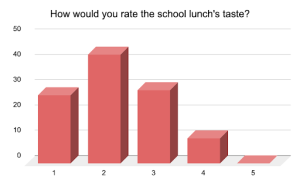The food being free at Fallon appeals to a lot of students. Daily, many come to the cafeteria before school for breakfast, and hundreds scurry to the long lunch lines in the afternoon. Despite the high demand for school food and its apparent popularity, much of it ends up in the trash. The school provides food all day for students. Some enjoy it and get it daily, but most complain about the food’s taste and overall quality.
Students have a more positive view of the school breakfast than lunch. Amani Habir, a 7th grader at Fallon, states, “I like the school breakfasts because there’s turkey bacon.” For lunch, two options (vegetarian and non-vegetarian) are available daily. Only one main dish is provided at breakfast, but if the students don’t like it, they can choose from various cereals.
Students are required to take a fruit, vegetable, juice, or milk with each meal. Although this seems like a good idea to ensure a balanced and healthy meal, Sahana Garikiparthi remarks, “It can be hard to like salads.” An 8th grader at Fallon, Sarah Chen, explains further, “I don’t think people eat them [salads]. Most people throw them away rather than eat them.”
One hundred Fallon students responded to a survey that asked how they’d rate the school lunch. The most common rating, picked by 40% of the students, was two out of five. This isn’t a coincidence. Most students respond with loud groans and scathing remarks when you ask about the school lunch. Why do the students at Fallon have such harsh opinions about the school food? Are they justified?
All of the dishes on the menu website have anonymous ratings based on the taste and quality of the food. Considering all lunches are provided for free, their weekly average rating of 3.5 stars out of 5 is impressive. Students at Fallon don’t seem to agree with this rating, though.
 Anaya Kodumuri, a seventh grader at Fallon, says, “Sometimes, there’s a lot of extra grease or oil on some of the food.” Taste is a prominent criticism from students. Aside from Wednesday’s popcorn chicken, most of the dishes were cruelly degraded in the survey, with one student describing the teriyaki chicken as “teri-yucky.”
Anaya Kodumuri, a seventh grader at Fallon, says, “Sometimes, there’s a lot of extra grease or oil on some of the food.” Taste is a prominent criticism from students. Aside from Wednesday’s popcorn chicken, most of the dishes were cruelly degraded in the survey, with one student describing the teriyaki chicken as “teri-yucky.”
Sixth grader Durga Kanamatareddy says she occasionally doesn’t finish her food because of the taste, expressing how it affects her in class. “I get really hungry, and I can’t concentrate that well.” She says, “There are very low portions of it, and we have to stay a whole two hours after lunch on that little portion.”
Ms. Meza is a food nutritionist at Fallon; she oversees the kitchen, inventory, and the crew that prepares everything for lunch and breakfast. “The portions? They’re good, as long as they take the veggies, fruits, and all of the components that have to be in their tray – not just the meal.” She goes on to say that the portion sizes are handled by the district and aren’t something she can control.
Ms. Meza adds, “I just wish the students took everything that we offer, especially the fruits and veggies, and that they didn’t waste so much food. Because I have a lot of students who just go and grab the stuff and throw it in the garbage. Like, right there. As soon as they get out of the Speed Line, they throw it in the garbage. That’s really sad.”
Furthermore, they have decided to put a price on water bottles that had been previously free when getting lunch. The students have not taken well to this. To elaborate, Raheel Mojaddedi (7) stated, “But we need water, and a lot of people don’t have water bottles, so the water should come with the lunch…” and when asked what effect this may have on students, she said, “I’m not paying attention in class because I’m feeling sick.” Since the school has taken out water, students have not been getting the water they need daily. If they get dehydrated, problems such as students paying less attention in class and needing medical attention can occur.
Students’ taste preferences are very scattered, and it can be challenging for the school to provide everything students need in their food. Keeping the students’ references in mind can provide the satisfaction many students need in their lunch break and reduce the amount of food being thrown away. While acknowledging Fallon’s changes to give the students better meals, it is also important to consider students’ needs.






















Shreya • Apr 17, 2025 at 7:42 pm
Yes, I agree with Durga too, but the water bottles make sense. If students are getting dehydrated, they can always drink from the water fountains. If people think thats gross, they can just bring water from home. The reason they banned it is because students were misusing it. Anyone reading this, PLEASE make an example so more privileges don’t get taken away. Anyway miss you Durga.
Madhura • Feb 25, 2025 at 9:11 pm
I agree with Durga. The portions are small, and I can never concentrate well in class. Thank you Durga.
Veer • May 10, 2024 at 1:05 pm
Durga was right; the portions are very small